Full Length Research Paper
ABSTRACT
This study examined sexual behaviours that are common among adolescents despite the fact that they go through some forms of sexual socialization as they grow in their communities and as they enter school. Data were obtained from adolescents in five local government areas of Western Senatorial District of Kogi State, Nigeria. In all, 781 respondents were simple randomly selected from ten communities where ten government secondary co-educational schools were used. Of this sample of 781 respondents, 768 were returned and used for the analysis. Due to the differences in the population of the school depending on the remoteness of the community, the Barlett, Kotrlik and Higgins’ Table Determining Minimum Returned Sample Size for a given population using the margin error 0.05 was used. Variables were cross-tabulated to calculate the Chi-Square using the t-test at 0.05 level of significance. The Focus Group Discussion (FGD) and in depth Interview techniques were employed to corroborate the quantitative technique. This implies that both quantitative and qualitative methods were used. Findings from the research work revealed the ineffectiveness of both the school and communities as agents of adolescents’ sexual socialization. Recommendations were made towards an improvement in sexual socialization through a refocusing on the agents of socialization for positive effect.
Key words: Socialization, adolescents, school curriculum, community, media, internet.
INTRODUCTION
The human species is the most dependent from cradle. This is why a child cannot survive without the aid of some significant others. This significant others primarily are members of his family and other agents of socialization which include; members of the immediate community where the child is reared, the school, peer group and the media. These agents affect the behavioural pattern and upbringing of children in significant ways. Socialization is defined as the process of inculcating in the child/ adolescents, the way of life (cultural practices) of the society into which the child is born\reared. Socialization is a process of learning and adjusting through which individuals acquire and internalize the values, beliefs, and behaviours which are acceptable to their community. It is this process of socialization that sets standard of behaviour for the incoming generation.
However, there is a problem in today’s westernized world on how sexuality matters are handled both by the community and the school. The community from which adolescents’ family operates has become very weak on sexual socialization and the school system with a well designed curriculum as aspects of compulsory subjects is not able to achieve much because of adolescents’ exposure to the media cum internet.
As opined by Adebola (2014), in traditional African society, socialization was all that was required to make every one conform to the order, norms and values of the society. This makes the control of adolescents easier than now. Superstitious belief also holds sway in the traditional African society. Today, however, the once cherished societal norms and values do not mean anything to this generation. Families are no longer available for the training of their wards. The society does not frown or punish any act of indiscipline any longer. All the beautiful ties that knotted the family and communal life have long been eroded. It is in the wake of this situation, that adolescents now turned to the available medium to learn about their body. With changing social, economics, technological and industrial status of society, the family is no longer a trading and farming unit, but a consumer of finished products. Factories, shops, banks, service agencies, schools, clubs and social welfare groups have developed and taken over the social and economic functions of the traditional family, thus removing work and services for families. When families were a production unit, children spent more time interacting with members of the extended family. They worked with family members, learning trade, farming or selling wares. With work and trading being done outside the home, the influence of the extended family as a social socializing agent becomes weakened. Also as the society has become more industrialized, the child no longer finds much use in family life (Odetola and Ademola, 1985).
There is today, increase in the number of working mothers. Economic pressure in the home now demands that most housewives work and have a career. In fact, in most cases, ability and willingness to work is more or less becoming a condition for accepting a woman for marriage. Owing to women’s increasing participation in wage labour, there is decrease in the amount of time parents now spend with their children. This development has great reliance on the school for the performance of some of the functions usually performed by the mother. Children now spend longer time in school than before; they start school much earlier, moving from pre-nursery, nursery and then primary (Okpanachi, 2006).
The argument puts forward in this research work is not to relegate the importance of the media as a good source of socialization because there are very salient ways that the media has contributed to children upbringing. Adebola (2014) asserted that the media especially the internet remains a valid source of information on important life issues. Uduebholo and Adebola (2010) while validating the importance of the mass media in socialization also explained that despite its negative role, we cannot throw away baby with dirty water as mass media has helped greatly in modeling children and adolescent’ behavior often through persuasions, reinforcement, thrills etc. Adebola (2015) stated that the family though weakened by today’s style of child training remains the best tool in socializing the child because it has all the repositories of the community’s norms and values. The school therefore remains an outlet for training children of nowadays and a lot of children today, start school at early age. Due to modernization, children today learn faster and are exposed to all forms of sexual habits which they learn from friends and the media. This situation poses a great challenge to the school system. The Federal Government of Nigeria, realizing the importance of sexuality education in the country, because of the myriad set of sexual health problems affecting adolescents, also developed comprehensive curriculum that covers all aspects of sexuality. The curriculum was developed as objective specific. The first in the series is in the 9- year Basic Education Curriculum (Basic Science and Technology for Primaries 4 - 6). In this curriculum, in primary 6, responsible parenthood is taught. The stated objectives for this include:
1. Pupils should be able to state the safe age for reproduction and the consequences of teenage sex.
2. Discuss the consequences of irresponsible sexual behavior.
3. Identify HIV and AIDS and its spread as a major consequence of irresponsible sexual behavior.
4. Discuss the health, social and economic effects of HIV and AIDS on the individual, family, and community (NERDC, 2007).
Likewise, in the Junior Secondary School Curriculum for PHE (Physical and Health Education), there is a topic, Family Life Education. The performance objectives are:
1. Students should be able to explain the various types of families.
2. List the duties of each member of the family.
3. Differentiate between puberty in boys and in girls.
4. List the consequences of pre- marital sex.
5. Demonstrate assertiveness and communication skills (NERDC, 2007).
It is in view of the above stated objectives, that programmes were drawn to also include students of Colleges of Education, who invariably will teach their students in the Universal Basic Education (UBE) schools. There is also students’ handbook covering family life and HIV and AIDS. Family Life and Emerging Health Issues Curriculum is designed to promote the acquisition of factual information, formation of positive attitudes and values as well as develop skills to cope with biological, psychological, socio-cultural and spiritual development as human beings. It is intended to build the confidence of the student teachers in imparting knowledge of Family Life and HIV/AIDS Education concepts at the basic school levels.Family Life and Emerging Health Issues (FLEHI) will allow the student teachers to have foundational and content competencies as well as skills and leadership in equipping learners towards attaining a healthy future.
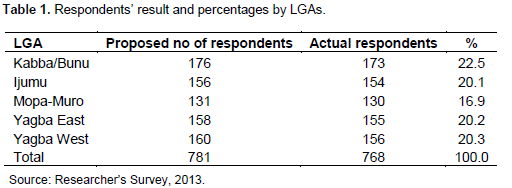
Despite all the efforts by the government through the educational system to see to the well-being of children and adolescents, their sexual behavior still remains a challenge because while the home and community has not measured up to standard in sexual training, the school where they would have learnt has become the place where they practice those negative behaviors watched through the media among themselves (peer group). To this end, this research work has the following objectives:
1. To examine the association between family/community socialization and adolescents’ sexual behavior.
2. To examine the effectiveness of the school system as a medium of sexuality education
3. To investigate the effect of media and internet on adolescents’ sexual behavior.
Research hypotheses
1. Ho: There exists no significant association between family/community socialization and adolescents’ sexual behavior.
H1: There exists a significant association between family/community socialization and adolescents’ sexual behavior.
2. Ho: There exists no significant association between school-based sexuality education and adolescents’ sexual behaviour
H1: There exists a significant association between school-based sexuality education and adolescents’ sexual behaviour
3. Ho: There exists no significant association between exposure to the media and internet and adolescents’ sexual behaviour
H1: There exists a significant association between school-based sexuality education and adolescents’ sexual behaviour
MATERIALS AND METHODS
The data for this research were obtained from adolescents in five local government areas of Western Senatorial District of Kogi State, Nigeria. Adolescents are teenagers who are transiting between childhood and adulthood. Their stages are determined by their age group. The first stage is the early adolescence, which covers the period of 11-14 years. The second is middle adolescence from 15-18 years, and the third is late adolescence from 18-21 years. All the age groups are well represented in the secondary schools used. In all, 781 respondents of which 768 were retrieved for analysis were simple randomly selected from ten communities where ten government secondary co-educational schools were used. Due to the differences in the population of the school depending on the remoteness of the community, the Barlett, Kotrlik and Higgins’ Table Determining Minimum Returned Sample Size for a given population using the margin error 0.05 was used. Table 1 is the summary of respondents’ result by percentage. Questionnaire, in-depth interview and Focus Group Discussions were employed in this research. The uses of these three methods allow for triangulation of the results of the research findings. This in effect authenticated the results because there were corroborations between and among findings from the three techniques used. This is very important in a scientific research of this nature. While the copies of questionnaire were used for only students’ respondents, both Focus Group Discussion and in-depth interview were used for the adolescents’ students and some selected teachers (Table 1).
RESULTS AND DISCUSSION
Table 2 show the results of the empirical findings that were analyzed to validate the objectives of the study. Sexuality education in schools, family and community norms and exposure to media/internet were cross-tabulated against different forms of adolescents’ sexual behaviours. The results validated high negative sexual attitudes demonstrated by adolescents despite the activities of agents of socialization with which they interact as they grow. The findings revealed that adolescents are involved in premarital sex, casual sex, and homosexuality despite forms of sexuality education available to them. These practices are considered negative in the context of the community’s norms on sexuality in most traditional African communities.

X2c = 2.493; Cramer’s V =0.057
DF = 1
P-value =.114
DF = 1
Decision rules: reject Ho if P-value 0.05
From Table 2, a number of descriptive and statistical deductions were made. The P-value of .114 is greater than 0.05, does not allow a reject the hypothesis of no difference (Ho). In essence, sexuality education in school has no association with adolescents having opposite sex friendship. This makes it clear that sexuality education in school is either non-existence or where it exists; it is not strong enough to stop adolescents from having opposite sex friendship. For this data, the Cramer’s V statistic is .057 out of a possible maximum value of 1 (57%). This represents a high association between sexuality education in school and adolescents having opposite sex friendship. This further strengthens the result of the X2 test. The implication of the above statistical result is that sexuality education curriculum in schools is not a good source of adolescents sexual norms internalization.
During one of the in-depth interview session, a male teacher who is 36 years old told us that:
‘Students of nowadays get involved in opposite sex friendship indiscriminately. One evil we have even discovered is students’ co-habitation. Many of the S.S 3 (Senior Secondary) students we have came from neighbouring towns to rewrite WAEC (West Africa Examination Council) or NECO (National Examination Council). When they come, they begin to co-habit since they usually rent houses to stay in. We have been involved in cases where the girls get pregnant severally. With all the moral talks we give; it’s so bad’.
A school principal shocked us when asked about how well they handle sexuality education in that school. In his words:
‘Is there anything like that? I know some subjects have topics treated mostly in Basic Science and P.H.E. but that is pure child’s play. If we will not deceive ourselves, the world has gone beyond that type of hanky-panky game. We sure need professionals to handle this generation on sexual matters’.
The quantitative and qualitative findings above is in consonance with the findings of Adepoju (2005), in her research, she validated the scarcity of sexuality education in Nigerian schools and asserted that this is one reason why adolescents have so much problems with sexual behavior (Table 3).
X2c = 133.47; Cramer’s V =0.417
DF = 1
P-value =.000
DF = 1
Decision rules: reject Ho if P-value 0.05
Descriptive and statistical deductions can be made from Table 3. Going by the statistical results derived from the table, the X2 data show that there is highly significant association between sexuality education in school and if adolescents have ever had sex. This decision is arrived at because the P-value of .000 is less 0.05 with 1degree of freedom. Therefore by this result, the null-hypothesis is rejected, while the alternative hypothesis which states that there is a significant association between sexuality education and whether adolescents ever had sex is sustained. For this data, the Cramer’s V statistic is .42 out of a possible maximum value of 1. This represents a medium association between sexuality education in school and whether adolescents ever had sex. This further strengthens the result of the X2 test. Adolescents are engaged in premarital sex especially in the school premises after school hours.
During a session of one of the in-depth interview conducted for teachers. Most teachers attested to adolescents’ in schools having illicit relationships and engaging in sexual acts among them. One of the principal referred us to the Vice Principal (administration) who he said is in charge of such cases as the head of the school disciplinary committee. The vice-principal, a middle aged man opened a log book where he showed us with dates, cases of sexual acts among students. The kind of punishment
‘If teachers said they are not aware that students engage in sex even right on the campus, then they are not saying the truth. There is no reason to lie, I am also a father and these children are the future hope of the nation. This finding is good. Let them know that secondary school students need real sexuality education that will be strong enough to make them stay away from sex as they prepare for a better tomorrow’
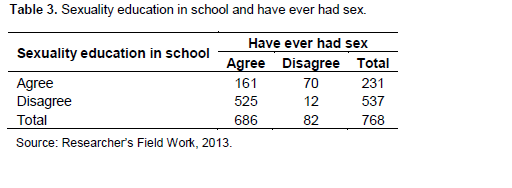
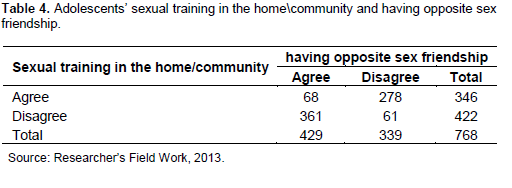
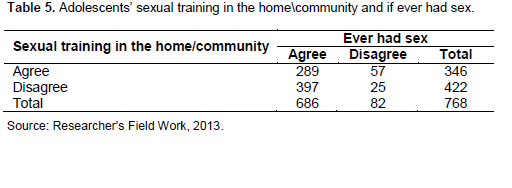
Using Pearson Chi-Square to calculate the P-value
X2c = 334.8; Cramer’s V =0.66
DF = 1
P-value =.000
Decision rules: reject Ho if P-value 0.05
Descriptive and statistical deductions can be made from Table 4. Going by the statistical results derived from the table, the X2 data show that there is a highly significant association between sexual training in the home or community and adolescents having opposite sex friends. This decision is arrived at because the P-value of .000 is less 0.05 with 1degree of freedom. Therefore by this result, the null-hypothesis is rejected, while the alternative hypothesis which states that there is a significant association between sexual training in the home or community and adolescents having opposite sex friend is sustained. For this data, the Cramer’s V statistic is .66 (66%) out of a possible maximum value of 1. This represents a high association between sexual training in home/community and whether adolescents are involved in opposite sex friendship.
When respondents were asked if they received any form of sexual training in the home or community where they live during the FGDs sessions, most of them said no. they reported that neither of their parents ever mentioned sexuality training to them. The quantitative and qualitative findings are corroborated by the findings of Francour et al. (2000), who through their research findings validated that among most ethnic group in Nigeria, sexuality education is handled secretly and only allowed to be discussed among the old married people.
Using Pearson Chi-Square to calculate the P-value
X2c = 22.19; Cramer’s V =0.17
DF = 1
P-value =.000
Decision rules: reject Ho if P-value 0.05
From Table 5, a number of descriptive and statistical deductions were made. Going by the statistical results derived from the table, the X2 data show that there is a highly significant association between sexual training in home/community and whether adolescents ever had sex. This decision is arrived at because the P-value of .000 is less 0.05 with 1degree of freedom. Therefore by this result, the null-hypothesis is rejected, while the alternative hypothesis which states that there is a significant association between sexual training in home/community and their sexual behavior is sustained. For this data, the Cramer’s V statistic is .71 out of a possible maximum value of 1 (71%). This represents a high association between sexual training in home/community and whether adolescents are involved in opposite sex friendship.


During the in-depth interview session adolescents, it was discovered that only few adolescents have sexuality training from home. One respondent spoke thus:
‘My parents have never mentioned anything to us about sexuality education. In fact, I have never heard anything like that being discussed in my community’
Another respondent told us thus:
‘My mother didn’t teach us any sexuality education per se, but she is always watching to see the types of friends we keep and has warned us severally about boyfriend because we are three girls in my family. So I think in a way she is trying to teach us to the best of her ability’.
Source: Researcher’s Field Work, 2013
X2c = 513.3; Cramer’s V =0.818
DF = 1
Decision rules: reject Ho if P-value 0.05
Criterion = P-value calculated .000 < 0.05, Implication, very highly significant.
Decision, Ho rejected
From Table 6, a number of descriptive and statistical deductions were made. The P-value of .000 is greater than 0.05. We therefore do not reject the hypothesis of no difference (Ho). In essence, there is a significant association between adolescents’ exposure to media and having opposite sex friendship. For this data, the Cramer’s V statistic is .82 out of a possible maximum value of 1. This is equivalent to 82% level of strength. This implies a highly significant level of association between adolescents’ exposure to the media and having opposite sex friendship. This further strengthens the result of the X2 test.
During the FGDs, all adolescent respondents participating agreed to the fact that the media played important role in their sexual behavior generally. There were no single respondents who have not been involved in watching home videos and tapes with such messages of sex display. One respondent told us that:
‘The simple truth is that there is none of us who have not been watching home video either through the CD or space dishes. All those African and Nigerian films are usually about sexual displays. It’s difficult therefore for anyone to want to shy away from it’.
A class teacher told us during one of the interview session that:
‘Children of nowadays are exposed to all sorts of bad orientations and teachings through the television and the internet. This is one reason a lot of them are not doing well in their studies. The kind of home videos they watch does not attach a sense of seriousness and hard work. They are rather made to see fantasies as if the only thing we live for is to have fun so hardly will you see any one of them wanting to engage in serious school work. They rather prefer that cheating be allowed during exam. This is the sorry situation we find ourselves in this country’.
X2c = 513.3; Cramer’s V =0.818
DF = 1
Decision rules: reject Ho if P-value 0.05
Criterion = P-value calculated .000 < 0.05, Implication, very highly significant.
Decision, Ho rejected
From Table 7, a number of descriptive and statistical deductions were made. The P-value of .000 is greater than 0.05. We therefore do not reject the hypothesis of no difference (Ho). In essence, there is a significant asso-ciation between adolescents’ exposure to media and whether they ever had sex.
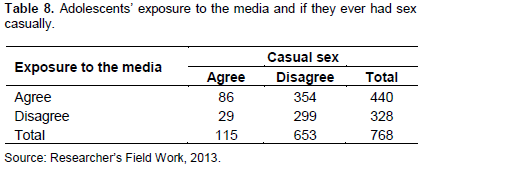
For this data, the Cramer’s V statistic is .82 out of a possible maximum value of 1. This is equivalent to 82% level of strength. This implies a highly significant level of association between adolescents’ exposure to the media and if they ever had sex. This further strengthens the result of the X2 test.
During the in depth interview in one of the school, a 39 year old female teacher told us that:
‘The evil we see today is as a result of television particularly home videos that our children watch. At our own time, if you don’t go to cinema house, you cannot watch film and you will not even get permission especially as a girl to go to such places because there is always enough home chores for you but today we parents bring these things right into our homes to deform our children and then we make noise that they are not hearing us. How can they? I have seen children of same parents impregnated themselves and when asked the girl said as they watch film, her brother ask her to let them practice what watch. Is this life?” She exclaim as she rounded up’.
A lot of the respondents also affirmed watching a lot of sexual display from the television and home videos and that most of the things they know about sex and opposite sex is from the television and other relevant media electronically.
X2c = 16.911; Cramer’s V =0.481
DF = 1
Decision rules: reject Ho if P-value 0.05
Criterion = P-value calculated .000 < 0.05, Implication, very highly significant.
Decision, Ho rejected
From Table 8, a number of descriptive and statistical deductions were made. The P-value of .000 is greater than 0.05. We therefore do not reject the hypothesis of no difference (Ho). In essence, there is a significant association between adolescents’ exposure to media and whether they ever had sex casually. For this data, the Cramer’s V statistic is .48 out of a possible maximum value of 1. This is equivalent to 48% level of strength. This implies a medium significant level of association between adolescents’ exposure to the media and whether adolescents ever had sex casually. This further strengthens the result of the X2 test.
During the in-depth interview session, most teachers attested to watching the television as being responsible for casual sex practices among even innocent students. A principal narrated an ordeal that he went through last term. He spoke thus:
‘I was in the office one early morning and two police officers came. They told us they came with respect to a youth corp member who was serving with us. Since the corp member could not be seen, I was arrested. We got to the station and I saw a J.S.S three student in my school who the parents reported missing the previous night to the police station. This girl is just twelve year old and she told her the corper invited her to his house and they watched all sorts of blue films together for about four hours after which the corper undressed her and started having sex with her from time to time. When later we discover the corper from one of his friend’s house he was forced to produce those tapes and when the tapes were played I could not believe my eyes. This is just one out of the many cases we have handled pertaining to television and sexual practices among our students, he added’.
Another teacher told us in one of the school that:
‘The effect of television and internet on the sexual life of our wards cannot be over emphasized. It’s unfortunate today that what the students are exposed via the media is destroying their future. You can imagine a girl instead of coming to school one day went to her boyfriend’s house. Both of them were students of this college. Having allowed their parents to go work, they watched films and as they watched they were also having sexual intercourse. It was a neighbour who supposed the parents would have gone to work and wandering the way the television was so loud who came to the door that was not locked and screamed at what she saw this children doing. Casual sex has led to many girls not being able to realize they were pregnant and even when they do, they will not be able to say who slept with them’.
Using Pearson Chi-Square to calculate the P-value
X2c = 651.1; Cramer’s V =0.921
DF = 1
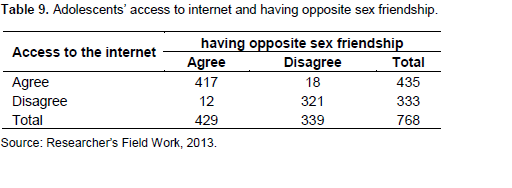
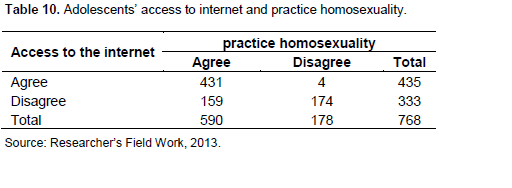
P-value =.000
Decision rules: reject Ho if P-value < 0.05
The internet is an aspect of the media which is also witnessing very high patronage by young people. Table 9 is a chi-square test of the association between adolescents’ access to the internet and having opposite sex friendship among adolescents. The P-value of .000 is less than 0.05 and highly significant. By implication, adolescents’ exposure to the internet allows them to engage in having opposite sex friendship. For this data, the Cramer’s V statistic is .92 out of a possible maximum value of 1. This is equivalent to 92% level of strength. This implies a very high significant level of association between adolescents’ adolescents’ access to the internet and having opposite sex friendship. This further strengthens the result of the X2 test.
There is no gainsaying that the internet is playing major roles in adolescents’ sexual behavior. During the FGDs, all selected respondents agreed that they have access to the internet. A lot of them also told us that they make friends through the internet.
An S.S one student who is about fifteen year old spoke thus:
‘Internet is good. I have many friends on the net. They are my girlfriend even though I have not met them. A lot of those friends, requested to be my friend. We enjoy our relationships and express our feelings through writings on the net’.
One lady respondents said:
‘I used to like friends on the internet until last year when a friend of mine travelled to an address sent through the net to her supposed boyfriend in the East. Up till now we have not seen her! So for me and anyone close to me, I don’t encourage internet friends anymore as some of them are for evil purposes’.
Using Pearson Chi-Square to calculate the P-value
X2c = 279.1; Cramer’s V =0.603
DF = 1
P-value =.000
Decision rules: reject Ho if P-value 0.05
The internet is an aspect of the media which is also witnessing very high patronage by young people. Table 10 is a chi-square test of the association between adolescents’ access to the internet and the practice of homosexuality. The P-value of .000 is less than 0.05 and highly significant. By implication, adolescents’ exposure to the internet allows them to engage in having opposite sex friendship. For this data, the Cramer’s V statistic is .61 out of a possible maximum value of 1. This is equivalent to 61% level of strength. This implies a high significant level of association between adolescents’ adolescents’ access to the internet and having opposite sex friendship. This further strengthens the result of the X2 test.
During the FGDs, all selected respondents agreed that they have access to the internet. When asked about watching pornographic sites, a few of them said yes. However, the teachers during the in-depth interview affirmed that a lot of them have access to pornography through their handsets. A class teacher told us:
‘I have seized more than twenty handsets in class. When you look at what these students watch with those phones you will be amazed. We have tried to discourage parents from buying handsets for these students but to no avail. They hardly concentrate in class, all you see them do is pressing the handset. Why would they not practice homosexuality when everyday they watch it in their phones? It is such an absurd situation. Only God can save us’.
Findings above corroborate the ineffectiveness of family and community socialization today. Globalization, which has turned the whole world into an accessed ‘village’ in a matter of second via the media and especially the internet has opened the eyes of children and adolescents to all sorts of malicious sexual practices which is usually followed by grave consequences on their sexual and overall health. Replete evidences abound in past researches that can be used to corroborate the quantitative and qualitative findings above. For example, researchers like Boyle (2001) and Aubrey (2004) both agreed that there is a direct relationship between the amount of sexual content adolescents watched and their level of sexual activities.
CONCLUSION
The empirical study above validates the ineffectiveness of both the community and the school in this age in tackling the problem of negative adolescents’ sexual behavior. More still need to be done if the sexual health of adolescents will be improved. There is need for societal norms as mores and folkways to be revived in the communities where adolescents are raised. Professional teachers who are specially trained in the skill of sexuality education should be employed to handle adolescents’ questions in schools, and there is need for viable guidance and counseling unit in schools where adolescents can be referred for help. More so, school curriculum should cover the nitty-gritty of sexuality and not just touched on some aspects while leaving other sensitive topics. We should also encourage children and teenagers to open up on sexual matters so that they can be helped on time. Media and internet do have a lot of advantages for children especially in this technology age; and since we cannot throw away the baby with the bath, it is imperative that media and internet activities be checked by governments and parents. This way we will be able to do a lot in correcting some misinformation adolescents already have about sex and thereby help them in avoiding damages to their overall sexual health.
CONFLICT OF INTERESTS
The author has not declared any conflict of interests.
REFERENCES
| Adebola OG (2015). Cover to Cover: The Whole Essence of Womanhood. Ilorin. Chridamel Publishing House pp.99-100 | ||||
| Adebola OG (2014). Determinants of Adolescents' Sexual Behavior, Sexual Health and Sexual Behaviour, Sexual Health and Impact of School- Based Sexuality Education among Okun-Yoruba of Kogi State. An unpublished Ph.D thesis submitted to the school of Postgraduate Studies, Kogi State University, Anyigba, Nigeria. Pp 24-7 | ||||
| Adepoju A (2005). Sexuality and Life Skills Education.London Pen Press Publishers. | ||||
|
Aubrey JS (2004). Sex and punishment: An Examination of sexual consequences and the sexual double standard in teen programming. Sex Roles. 50 (7-8): 505-514. Crossref |
||||
| Boyle M (2001). Sexuality, Contraception and the media. Pediatrtics 107(17):191-194. | ||||
| Bartlett JE, Kotrlik JW. Higgin CC (2001). Organizational Research: Determining Appropriate Sample Size in Survey Research. Information Technology, Learn. Performance J. 19(1). | ||||
| Francour RT, Esiet U, Esiet N (2000). (April/May).Ethnic views of sexuality in Nigeria.SIECUS Report, 28(4): 8-12. | ||||
| Nigerian Educational Research and Development Council [NERDC] (2007). 9-Year Basic Education Curriculum: Basic Science & Technology for Primaries 4-6.UBEC. Abuja. | ||||
| Okpanachi SS (2006). Introduction to Comparative Education Ibadan. Safmos Publishers. | ||||
| Odetola O, Ademola A (1985). Sociology, An African Introductory Text. Ibadan, Macmillan Publishers. | ||||
APPENDIX
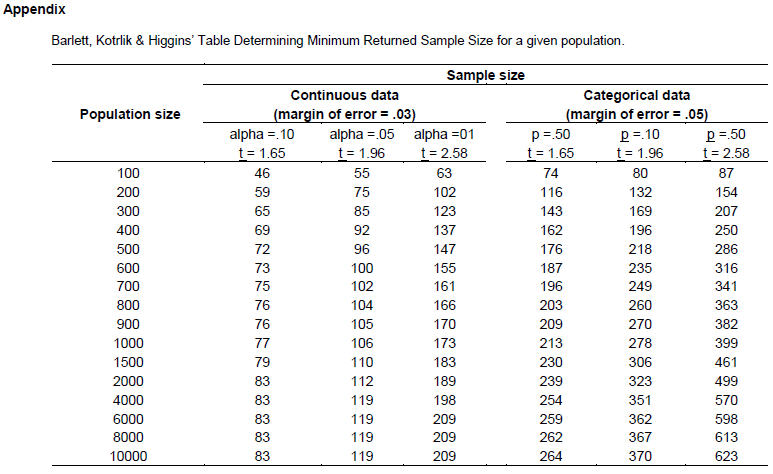
Copyright © 2024 Author(s) retain the copyright of this article.
This article is published under the terms of the Creative Commons Attribution License 4.0